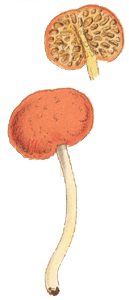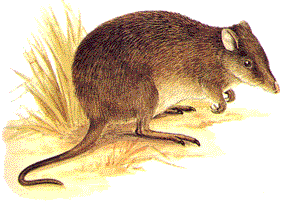 Fungal
ecology
Fungal
ecology
Fungi and vertebrates
At least 30 species of Australian mammals have been found to eat fungal fruiting bodies. The animals form quite a varied group: Mountain Pygmy-possum, various native rodents, various macropods (kangaroos, wallabies, pademelons, Quokka), Yellow-bellied Glider, Mountain Brushtail Possum, Common Brushtail Possum, Bettongs, Potoroos, Bilby, Bandicoots and the Common Wombat. These animals are distributed over a wide variety of habitats, from rainforest to desert. Given the lack of comprehensive dietary studies, the current list of fungal-eating native mammals is undoubtedly incomplete. In some cases there have been sightings of fungal consumption, but most of the evidence comes from fungal spores found in animal droppings. The spores of many fungal species are fairly robust and able to pass, undamaged, through an animal's digestive system and out with the faeces.
|
|
While we know that at least 30 species of native mammals eat fungi, the level of consumption is largely unknown. A number of these mammals are undoubtedly only occasional eaters of fungi. However, fungal consumption by some of the smaller mammals has been well-studied in south-eastern Australia and it has been found that the truffle-like fungi feature heavily in the diets of these mammals. The eating of fungi is well-developed in the rat-kangaroos (a marsupial group which includes the bettongs and potoroos). The Long-nosed Potoroo (Potorous tridactylus) of western Victoria eats over 40 different species of fungi, the majority of which are truffle-like fungi. The rare Long-footed Potoroo (Potorous longipes) of eastern Victoria and southeast NSW eats at least 33 species and the Tasmanian Bettong (Bettongia gaimardi) eats at least 49 species. For Potoroos and Bettongs in general, fungi (mostly truffle-like) constitute at least 30-40% of the animals' diets throughout the year - but there is considerable variation between the species. For example, truffle-like fruiting bodies constitute 80-90% of the diet of the Long-footed Potoroo, regardless of season.
In the three-way (tree-fungus-marsupial) association it is clear that there is a benefit to all parties. Tree and fungus each benefit from the other through their mycorrhizal association. The animal uses the fungus for food, but then helps disperse the fungal spores.
Elsewhere in the world many animals are known to eat fungi and the truffle-like fungi are especially attractive to various animals - including various small rodents, deer, elk and bears. Squirrels will dig up truffle-like fungi and leave them to dry on tree limbs. In South America opossums and pigeons eat Cyttaria fruiting bodies. Siberian Jays have been found to feed heavily on fungal fruiting bodies early in winter - with the fungi apparently pilfered from squirrel caches. Other birds have also been seen pecking at various types of fungal fruiting bodies, but in some cases the birds may be after any larvae inside. However, in the Kuwaiti desert there is one truffle-like species (Phaeangium lefebvrei) which is deliberately scratched out and eaten by at least eleven species of migratory birds - and the Bedouin Arabs use the fruiting bodies for bait when they want to catch live birds.
New Zealand lacks the small mammals, that are so widespread in Australia, but
has a number of ground-dwelling birds occupying similar ecological niches. While
there is still much to be learnt about the New Zealand truffle-like fungi, a
number of species produce very strikingly coloured fruiting bodies, for example
Paurocotylis pila ![]() ,
Thaxterogaster porphyreum and Weraroa erythrocephala
,
Thaxterogaster porphyreum and Weraroa erythrocephala ![]() .
When these appear in the leaf litter of the forest floor, they look much like
the seeds of liliaceous plants or the fruits of conifers like Podocarpus
and its relatives. It is possible that the various ground-feeding birds are
attracted to these colourful fruiting bodies, mistaking them for plant seeds
or berries, and then eat them. Later the fungal spores would pass out in the
bird droppings, so the birds would act as dispersal agents, filling the role
played by the various small mammals in Australia.
.
When these appear in the leaf litter of the forest floor, they look much like
the seeds of liliaceous plants or the fruits of conifers like Podocarpus
and its relatives. It is possible that the various ground-feeding birds are
attracted to these colourful fruiting bodies, mistaking them for plant seeds
or berries, and then eat them. Later the fungal spores would pass out in the
bird droppings, so the birds would act as dispersal agents, filling the role
played by the various small mammals in Australia.
Do some Australian birds actively seek out truffle-like fungi? There certainly are colourful truffle-like fruiting bodies in Australia, a number of which do protrude above the ground and resemble berries in the leaf litter. Furthermore, a number of berry-eating birds come to mind – for example, Cassowary, Brush Turkey and Emu. On one occasion an Eastern Yellow Robin has been happy to take truffle-like fungi flicked to it.
Various Australian birds are happy to eat other types of fungal fruiting bodies.
In northwest Victoria, the Malleefowl has been seen eating small mushrooms (seemingly
in the genus Paxillus), Cassowaries are known to regularly eat some bracket
fungi, Brush Turkeys have been happy to eat small mushrooms of the genus Mycena
that were offered to them and Emus have taken immature puffballs (Lycoperdon
and Bovista species). ![]() However,
there has been no systematic study of birds and fungi.
However,
there has been no systematic study of birds and fungi.
The authors of the paper given in the next reference button wrote:
...we observed a large adult Eastern Blue-tongued Lizard Tiliqua scincoides..move towards the base of a mature Coastal Rosemary shrub Westringia fruticosa and commence digging. We realised that the lizard was digging for fungi when it retrieved and quickly consumed a white, ball-shaped mass that had not been visible from the surface. At this point we disturbed the animal (which retreated a short distance) and recovered three more ball-shaped fungi which resembled the 'eggs' of immature stinkhorn or anemone fungi...One of these was offered to the lizard which immediately consumed it...and another was allowed to mature in our laboratory..
.
The fungus turned out to be Aseroe rubra. The authors summarized the reports of fungus consumption in two species of Egernia and six of Tiliqua. Taken together, these seven lizard species have been seen to eat a variety of fungi (mushrooms, boletes, truffles) but generally the fungi had not been identified even to genus. Earlier research had shown that some lizards had been shown to be capable of identifying plant food chemicals. The authors of the above-mentioned paper therefore suggested that lizards could be significant spore dispersers in areas where few mycophagous mammals.
Fungi on humans
While there are many fungal parasites on humans, the bulk of them are microfungi (and so outside the scope of this website). Thrush, ringworm and athlete’s foot are three commonly known examples of such infections. Some macrofungi have also been found in humans. Schizophyllum commune is a cosmopolitan species, found on dead wood of many plant species and, for most of the time, gets along with its decaying of wood and doesn’t bother humans. However, the Schizophyllum mycelium has been found in humans, especially those with an imperfect immune system – such as HIV patients and those given immuno-suppressive drugs. In at least one case the actual fruiting bodies of Schizophyllum commune were found growing in the sinuses of a patient. The species appears to be an opportunistic human pathogen and, given the chance, will infect humans but in the great majority of cases human immune systems easily keep the fungus out. The mycelium of Coprinus cinereus, [http://www.cx.sakura.ne.jp/~kinoko/01eng3/coprinus_cinereus3.htm] has also been found within the human body. Ordinarily this is a saprotrophic species that produces medium-sized greyish mushrooms as fruiting bodies. Both of these species are examples of the ability to move from one behaviour to another – depending on circumstances.
Before panicking, it’s worth remembering that even while you’re reading this you’re probably breathing in some fungal spores. In fact you’re probably breathing in some fungal spores at almost every minute of the day, for fungal spores are widespread. If your immune system is in reasonable shape, there are no problems.
![An Australian Government Initiative [logo]](/images/austgovt_brown_90px.gif)




